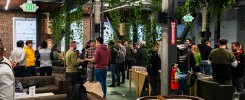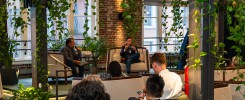Dispersed – the “new normal” that isn’t new
Discussions around the dispersed, distributed workforce have been brought to the fore by the recent mass work from home experiment. The concept is not, however, new. While many of us have had the flexibility to work from home, coffee shops, cars, trains, airports for many years, the most forward-looking companies spent the last 2 years focusing on their distributed workforce programs.
Indeed, we at Werqwise have been hosting remote offices for some of these firms, large and small, since we opened in 2018. We have recently all seen the benefits of the dispersed workforce, our challenge is adapting to this new normal and formalizing it on a large scale. As the balance shifts away from super-campuses and offices, how do we make sure that we don’t lose their benefits and cause large increases in employee turnover. The balance between working at the corporate campus, the office near home, coffee shop, while on the move and at home is different for each company, team and individual.
There is no doubt that working from home leads to productivity boosts for many people as less time is spent commuting and there are fewer interruptions from co-workers, but this productivity increase is short lived in many roles given the lack of those unplanned, unintended interactions. And this is without even considering the mental health impact.

Before COVID-19 11% of working Americans reported suffering from symptoms of depression, how much is this going to increase? Recent surveys have suggested that this is now around 30%. Many of us suffer from Zoom fatigue, a feeling of disconnection from the rest of our team. We miss the feedback, learning and growth that naturally happens when we are around others we trust.
While the psychological impact can be enormous, we must not forget the physical impact. The aches and pains of not having our ergonomic chair, the health impact of missing the sit stand desk, even the walk to the office seem to have been taken for granted. Careful consideration does, of course, also need to be given to confidentiality and security of proprietary information, equipment, and processes. Yet there is much more we need to consider. How do we hand a product off from one life cycle to the next, how do we work in a coffee shop without power, with limited internet and surrounded by ever changing people?
Engaging people and ensuring the deep connection with the company culture and brand is already hard when people are in the same location. It becomes exponentially more difficult to build teams, loyalty, focus on a core purpose and a sense of belonging when people are dispersed. Business is a human endeavor and as human beings we crave belonging and social interaction; working remotely, and in particular, from home, has a huge impact on us all.
The largest organizations will, of course, find ways to deal with these problems but what about everyone else? Smaller companies simply do not have the financial, operational and technology resources to solve the problem from even the simple perspective of the physical workplace or real estate. We cannot, however, afford not to solve the problem as getting it right can lead to explosive growth. This growth breaks the physical workplace model because real estate is long term and explosive growth is rapidly changing in real time It demands flexibility from the workplace to be in sync with the rest of the business. Thinking, behavior, process, and traditional norms need to change for real estate to be a contributor to our currency of high performance.
The Currency of High Performance - how must Real Estate respond?
Current real estate structures are not adding to the currency of high performance and in many cases, it is a negative contributor. The addiction to the long term lease caused by long standing views of the value of buildings coupled with the conditions under which financial institutions are willing to finance those buildings have largely stopped the industry from changing in a meaningful way for over 100 years. This enormous industry, $2.7 trillion in America alone, is hard to change but it must change.
The growing void between the demands of ever-changing business, social and human environments, and the current needs of landlords, developers and their financial backers needs to be closed. Flexibility and adaptability are now core business requirements, businesses need to make decisions in real time. Flexible workspace operators were created to solve this problem, yet most build fixed, generic products that try and fail to meet fundamental needs by offering a one-size fits all solution. The flexible workspace industry was founded to serve the dispersed workforce and provide businesses with flexible, turnkey solutions.

The industry should be connecting the different parts of the business continuum like a glue, yet it is often too inward focused. Many operators fail to listen any more than traditional real estate and are too internally focused to provide anything more than lip service to humanizing the workplace, to making it bottom up not top down. Sure, you can get flexibility on term, meet interesting people, share ideas and work in a cool space, but these are the basic fundamental factors. They should go without saying, not be the end point of the solution. While it is easy to find an office near where people live, the support for confidentiality and security is often limited or prohibitively expensive.
For a workplace to be effective it needs to connect people with the culture, purpose, brand, and overall mission of each business, not that of the flexible workspace operator. For the world of real estate to connect with the changing world of work. we need a new solution. We need a new breed of workplace operator providing for all the needs of companies and people now and in the future. An operator that provides the missing link that combines amenity and hospitality rich environments, designed to connect people with their company culture, brand, mission and team, with the flexibility to allow for rapid change on a turnkey basis.

The future of the workplace is dispersed, a hub and spoke model. It meets the needs of business and people with real flexibility. It is a bottom up solution that is diverse and physically, and psychologically, safe. It is rich in amenities, hospitality, and services. It is engaging, collaborative and provides all the conditions for the spark of innovation and creativity to lead to explosions. It allows workstyle to fit into lifestyle.
It is time for a new real estate solution, one that quickly and flexibly customizes spaces for each unique company and team. A solution that meets business requirements for flexibility, agility, confidentiality, and engagement that removes distractions yet encourages the spark that comes from unintended, unplanned interactions. A solution that ultimately unlocks the secret to high performance in the changing world of work with all above existing in a seamlessly connected continuum.
We, at Werqwise, believe we have an answer to providing this missing link between the real estate model built for rigidity and permanence and the world’s demands for real time flexibility and adaptability. Our proof of concept location has proved this can be done. By using technology, unique build systems offering almost infinite modular variation, customization and branding combined with high levels of listening, hospitality and focus on the end user, operators can create this missing link and deliver it in a sustainable and profitable way.


